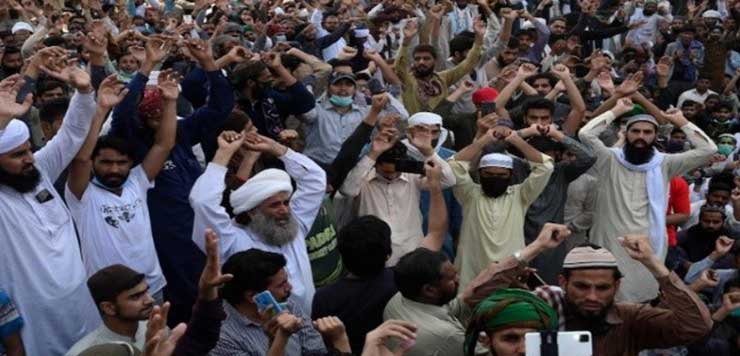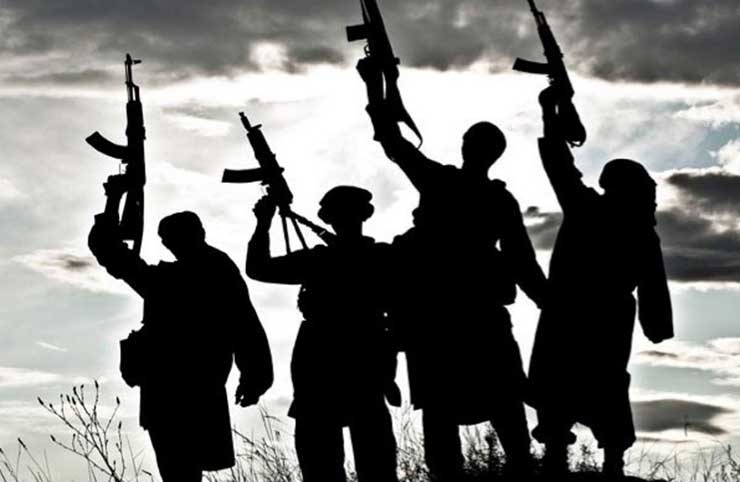
Current Upheaval
In recent times Pakistan has been in the news for all the wrong reasons. It’s not that previously it has showcased some path-breaking achievements, but it was never as bad. They are simply breaching their own poor standards in the global value indices. The country is going through utter chaos and upheaval with No immediate resolution in sight. Pakistan’s economy has nosedived to a historical low; the Pakistani rupee has crashed to a record low of 207.5 to one US dollar. Forex reserves have evaporated to USD 16.4 billion, creating a balance of payments problem. Even servicing its previous debt is in doubt unless Pakistan secures more loans from just about anywhere; it is that desperate at the moment. Moody’s credit rating for Pakistan is at B3 – equivalent to the Solomon Islands and unlikely to improve till it gets out of the FATF grey list.
With no respite from the worsening economic situation, the tantrums of the erstwhile PM Imran Khan couldn’t have come at a worse time. He is dishing out daily threats to the government and the military establishment with mass demonstrations, with no assurance of them being peaceful. He is not faking, and he proved this point on 25th May 2022 when PTI workers caused mayhem in Islamabad, destroying and burning everything that they could. It was a violent and blatant message to people in the power corridors to heed Mr Khan’s demand or else more of the same would follow. This time round, even the General doesn’t seem interested or probably has lost some grip on the situation. Although later, one appears more reasonable assumption with multiple instances pointing towards it. Mr Khan’s name-calling of the Army, social media narrative building against the establishment or a large number of former and current military officers expressing their reservations about policies adopted by General Bajwa. Issues are numerous; what is astounding, though, is that not a single institution in Pakistan appears concerned enough to handle them.

What’s Raging The Fire
Pakistan has long outsourced national policy management to its Generals, who publicised efforts to match their Eastern neighbour while only being interested in enhancing their personal treasures.
They fed the fear of India on a daily basis and their indispensability for fighting terror in Afghanistan. The approach ensured massive funding, which remained largely unaccounted for. To an estimate US alone gave USD 33 billion while oil rich Muslim countries like Saudi Arabia, UAE and Iran bought the ‘Islamic Bomb’ theory and bankrolled Pakistan. Post US withdrawal from Afghanistan and Pakistan stood exposed about its double game. It was a classic case of – running with the hare and hunting with the hounds. Pakistan, on the one hand, took money, recognition and backing from Americans while giving intelligence, cover and diplomatic support to the Taliban. It was too outrageous and had to end one day, and it finally happened on 15th August 2020. It was America’s 2nd humiliating withdrawal after Vietnam.
One can bet that the Americans didn’t like it; they are not people who forget in a hurry. In September 2021, the US instituted The Afghanistan Counterterrorism, Oversight and Accountability Act to investigate the role of the Pakistani government in the Afghan fiasco. The legislation specifically required, “an assessment of support by state and non-state actors, including the government of Pakistan, for the Taliban between 2001 to 2020”.
American dollars, which had mainly sustained the military’s economy, suddenly dried up. Courtesy of some deft Indian diplomacy, several Muslim countries got a sense of the Pakistani bluff. Pakistan’s Islamic card was no longer a cash cow. Moreover, they were asked to account for the funds given. Pakistan was not prepared for that, and they tried whatever they thought would work – from negotiations, to sending their General to lead the military operation of the Saudi coalition, to their PM playing chauffeur to Saudi prince Mohammad Bin Salman. Once the money from the US and oil-rich Middle East kingdoms withered, the Pakistani Military turned to civilian resources. Being used to remain unaccountable and expert in techniques of institutional diversion of funds, they drained their own national reserves.
The Pakistani Military takes the major credit for the current crises in the truest sense. Pakistan has more such pearls; add Mr Khan to that, who is convinced that the only way forward for Pakistan’s destiny is for him to become PM for life. The government of the day has no clue about handling the economic condition and their ex-PM. General Bajwa’s plan of – ‘we will remain neutral’ did not really work either. It only exposed his incapacity and became the catalyst for the unfolding political drama.
The Protagonists
In all this ongoing fiasco, there are four key players; the politicians, the radicals, the economy & the Army. Barring the Army, none have been Pakistan’s strong point ever. The economic downturn has exposed the bitter reality, with each of them having a go at the other, whichever way one sees it. There’s already a war within, and this one is not going away without causing destruction.

Pakistan’s politics has hit a new bottom. Pakistan’s media is full of images of how the current PM was heckled by PTI supporters in Saudi Arabia, how the former National Assembly deputy speaker of PTI Qasim Suri was dragged and manhandled by PDM workers in an eatery, and so on. There are plenty of such incidents.
On the other hand, the enigma of radicalisation has hit the roof there, where law enforcement agencies have to plead with a Kalashnikov-toting maulvi to take down the Taliban’s flag from his Madrasa or when ISI officers were recorded on video handing cash envelopes to protesting workers of Maulana Fazlur Rahman’s radical party Jamiat Ulema-e-Islam to call off their protest. The situation as it is: Political leaders can’t stand together, radicals continue to gain space from politicians and the Army, the Army wants to continue regulating the political process, while politicians like Mr Imran Khan have effectively decided it’s time to call out the Army Chief. Chaos would be a gross understatement to describe what Pakistan is going through.
Flirting With Danger
With a totally disoriented national approach, the focus has shifted to individual scripts for each of the major stakeholders in Pakistan. In Pakistan, it appears everything comes before the nation. When the question is of survival, thinking like a statesman is definitely not a priority.
In Pakistan’s political herd, each shade is only darker and murkier than the other. Replacements are not available and if they do exist, they come at a heavy cost. How else can one describe the scenario where a sitting PM who supposedly replaced a previous corrupt PM is himself under investigation for a multimillion corruption case? That’s Pakistan today, hopping from one crisis to another.

Its clueless polity is simply too preoccupied to pay attention to the larger picture, fearing that the rug may be pulled out from an unexpected corner. Amidst continued criticism of military leadership and political hara-kiri, the military bureaucracy is going with the templated job, as usual, harnessing their Kashmir dreams. The recent months have seen an increase in infiltration attempts, terror activities and targeted killings in Kashmir.
This usually is an indication of heightened frustration among terror outfits and their ISI masters. There also appears an attempt by Pakistan to keep the terror activities below a certain threshold, to not gravely provoke India while it actively enjoys prime time coverage. The danger is that with the leadership crisis in Pakistan, control of events may get swiftly out of hand. In any case, the ‘threshold’ is for India to decide, and in all likelihood, it will continue its downward trajectory. The price would be costlier for Pakistan the next time India makes it pay. It may cry wolf again like Kargil, that its government was not kept in confidence by the establishment. But it should better know that the onus lies squarely on the state for all acts that originate from its soil.

The Reprisal
The projection of the worst-case scenario and doomsday has begun within the nervous intelligentsia in Pakistan. A lot of discussion on the issue can be seen in their national media. The economic breakdown appears to be the most worrying of them all. The threat of Balkanization seems a bit farfetched; a more realistic possibility is that Pakistan will not be allowed to go bankrupt like Sri Lanka. The West believes a broke Pakistan is more dangerous; in all probability, some midpoint in negotiations will be worked out with lenders. Pakistan will be willing to swallow humble pie and agree to some stringent conditions imposed on them by the IMF.
This is largely because its black economy, which keeps the corrupt elites afloat, is massive. As usual, no one there is really bothered about the poor population. The left over middle class will be kept busy with fanciful issues, like – ‘The Indian conspiracy’, ‘Islam Is in Danger’, and ‘Kashmir is suffering’. These hashtags are like hot cakes in Pakistan, and they always sell well. The slump in the military economy will not only continue to put an added burden on the common populace, but also will create severe discontent among the top hierarchy due to the sinking financial leverage. The Pakistani Military knows funds are with the West, but the strategic challenge of asking for them at the cost of extreme Chinese displeasure is holding them back; so much for the iron brothers! Caught between a rock and a valley, Pakistani leaders should be worried about their adversary, who is observing and learning continuously. Each of their terror attempts and radical aspirations has been analysed and will be deftly thwarted and strongly countered. They will not be allowed to get away without paying for their deeds. If they are intelligent, they should also think about how and why they are caught in a complex web of chaos from all ends possible. After all, not all their troubles, can be natural coincidences. It’s highly likely that they have already begun paying for their past sins. Pakistan can definitely choose to continue in its self-denial & self-destruction mode for as long as it can, but with each passing day, the Truth will continue coming closer home until it finally knocks on the door!
–The writer has varied experience in security paradigm and is a keen follower of international geopolitics. He is also the author of popular blog site (geostrat.in) on geo-strategic affairs. The views expressed are personal and do not necessarily reflect the views of Raksha Anirveda








